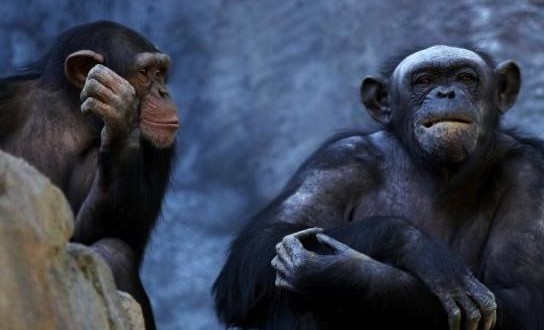Chimpanzees, the closest living relatives of humans, have their own way of communication, which includes various gestures. A team of scientists has claimed in a new study that they have for the first time successfully decoded what these apes are attempting to say through different movements of their bodies, hands and feet.
The result of the observation of over 80 wild chimpanzees is a ‘dictionary’ of meanings behind gestures such as arm raises, ground slaps and foot stomps.
The work was carried out by St Andrews primatologists Dr Catherine Hobaiter and Professor Richard Byrne in the rainforest of Uganda.
The results, published by the journal Current Biology, enhance the long-held belief that our closest living relatives have a purpose when they communicate with each other.
Although it has been known for some time that apes use gestures to communicate, until now no one has worked out what they are actually trying to say.
Professor Byrne, explained:
“There is abundant evidence that chimpanzees and other apes gesture with purpose. Apes target their gestures to particular individuals, choosing appropriate gestures according to whether the other is looking or not; they stop gesturing when they get the result they want; and otherwise they keep going, trying out alternative gestures or other tactics altogether.
“It has been known for over 30 years that chimpanzees communicate in this way, but oddly enough nobody has attempted to answer the obvious question, what are these apes actually trying to ‘say’?”
In a significant first step towards answering this question, the St Andrews researchers studied the behaviour of chimpanzees in the Budongo Forest, Uganda. Using video to record communicative interactions, they extracted over 4500 instances of gesturing.
They looked specifically at non-playful uses (because in play, gestures may not be used with their ‘real’ meaning) and identified specific meanings for most of the chimpanzee repertoire of 66 gestures.
Amongst the meanings discovered, they found that when a chimpanzee taps another it means ‘stop that’; a hand fling or slapping an object means ‘move away’; while an arm raise means ‘I want that’ or ‘give me that’.
Dr Hobaiter explained:
“Just as with human words, some gestures have several senses, but importantly the meanings of chimpanzee gestures are the same irrespective of who uses them. Chimpanzees may use more than one gesture for the same purpose – especially in social negotiations, where the final outcome may be a matter of some give and take”.
The next steps will involve the St Andrews researchers investigating possible variations in meaning behind certain chimpanzee gestures.
Dr Hobaiter added, “Now that the basic chimpanzee gesture ‘dictionary’ is known, we can start to tackle other interesting questions. Do some gestures have very general meanings, where their intended sense is understood from the context? Or do subtle variations in how a gesture is made determine which sense was meant?”
Agencies/Canadajournal
 Canada Journal – News of the World Articles and videos to bring you the biggest Canadian news stories from across the country every day
Canada Journal – News of the World Articles and videos to bring you the biggest Canadian news stories from across the country every day



